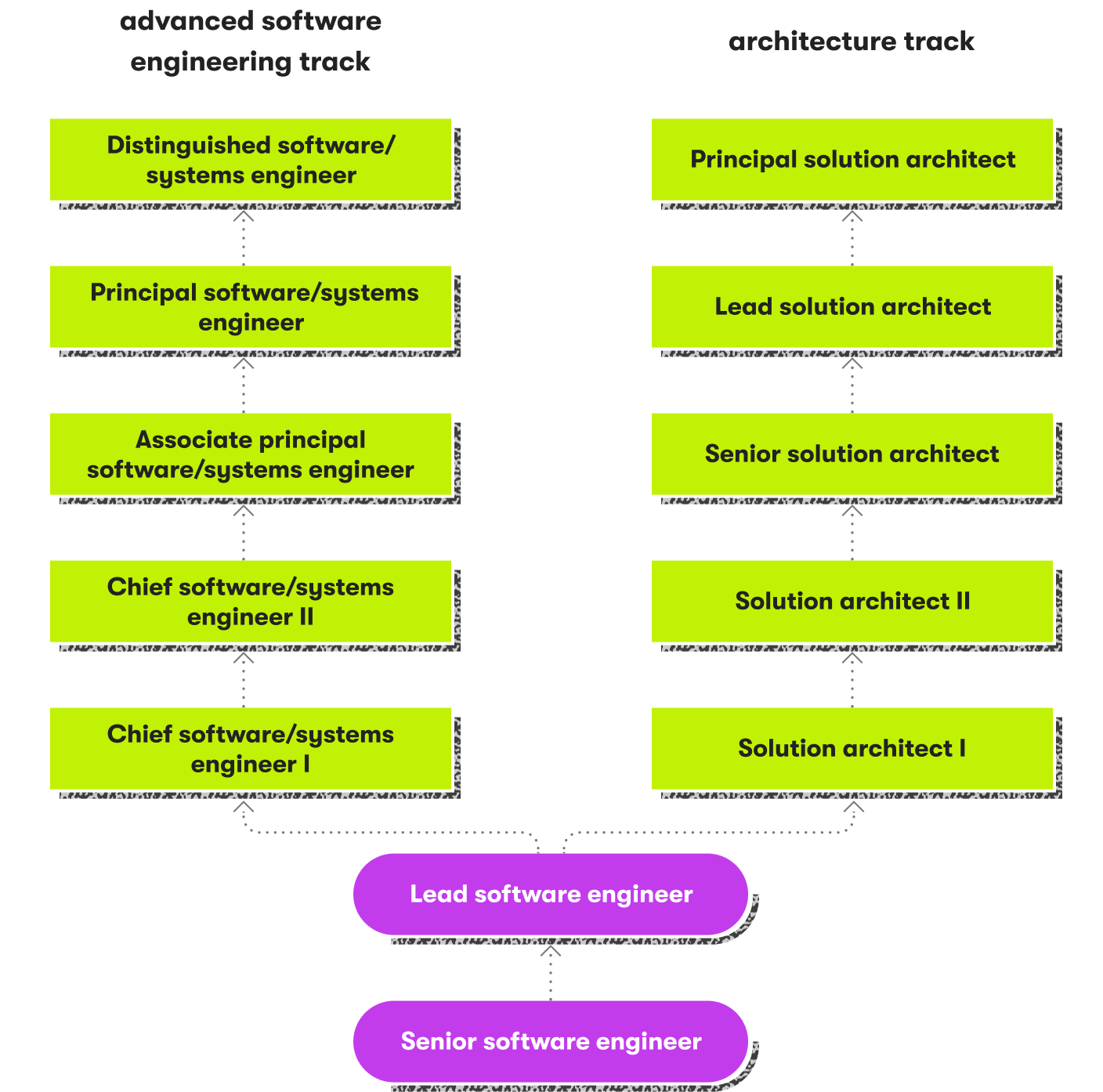If you want to know how to grow in your career in tech, where do you start?
This guide will give you an idea of specific software engineer career paths, plus advice on how to have a productive career growth conversation with your manager. It will also give you tools to help you build your career development plan.

Technical vs managerial career tracks: solving the dilemma
It is an unfortunate myth that engineers and managers are in entirely different leadership and technical skills bubbles. Another common misconception is that leaders and managers are interchangeable. Neither of these statements is accurate.
Understanding the differences between technical and managerial career tracks can lead to a better understanding of leadership in general and help you plan your career trajectory. Here is a quick comparison of the two paths:
- Engineers at the top of their career path have mastered programming languages, including Python, C, SQL, and Java.
- Managers focus on being excellent negotiators, strategists, and overseers. They must also maintain a good understanding of the software engineering process. Managers in the tech industry clearly need exceptional people skills, but they won’t get far without solid technical skills.
An engineer’s leadership skills are often demonstrated through mentoring. Their mastery of the programming fundamentals is an ocean of knowledge that junior engineers in their teams can leverage.
Knowing that engineers and managers have some crossover can enable you to tailor your skill development. You can ask yourself: “what style of leadership appeals to me?” Some other questions you may want to ask yourself to assess your leadership potential include:
- Do I enjoy creating strategies?
- Do I want to communicate with clients and upper management to establish project expectations?
- What sounds better to me: troubleshooting problems or establishing long-term milestones?
- Do I want to excel at managing people, or do I prefer working with programming tools?
- How am I at delegating tasks?
If you are unsure about your answers to these questions, talking with your co-workers or supervisors might help you better understand your professional aspirations. Ultimately, you may find that the best way to address the dilemma of technical vs. management career paths is to try one of them out.
Options to grow your career within engineering
Below is an image identifying available career paths for senior and lead software engineers at EPAM Anywhere:

One available track is Advanced Software Engineering. This path requires a comprehensive understanding of different programming languages and solutions.
The tools that I use to help me grow professionally? Roadmaps and boards like Trello, Roadmunk, and Notion. A calendar with reminders so you can track items you’ve completed. Also, I would recommend reading books about time management and self-organization.

The other track we identified, architecture, focuses on responsibility for tech solutions to meet business needs. Specialists in this group still qualify as engineers, but they focus on the overall technical vision for a project.
Your path and primary skill emphasis will differ depending on which direction you choose, but you’ll also find some significant crossover in the skills required for each.
Becoming an advanced software engineer
Becoming an Advanced Software Engineer (ASE) requires technology leadership. An advanced engineer leverages their understanding of various programming languages and allows their coworkers to benefit from their expertise.
Other aspects of the advanced engineering job include:
- A focus on research and development incorporating the latest technologies
- The ability to overcome complex technical problems
- The ability to work with time-sensitive projects and support junior engineers
An ASE differs from a lead software engineer in the depth of their knowledge. While leads have a high-level picture of a system, an ASE can troubleshoot specific system components. Both leads and ASEs also differ from solution architects.
Becoming a solution architect
An alternative career path you can choose is that of solution architect (SA).
SAs need to have a fundamental understanding of architectural theory. Architecture in this context refers to the framework of the overall system. System architects, for example, focus on company infrastructure services.
An SA acts as a liaison between the team and the project stakeholders regarding the technological side of the project. An SA also needs significant people management skills.
A solution architect typically performs these duties:
- Evaluating, designing, and implementing tech solutions
- Building problem-solving and system improvement strategies
- Reviewing the design and technical aspects of a potential solution
- Communicating with stakeholders
- Estimating project resource requirements
- Conducting meetings
- Identifying and addressing inefficiencies in a team or system
Lead engineers are similar to SAs but leads typically focus on the efficiency and functionality of an entire project. SAs provide general ideas for how technology can work to benefit the business. Leads can eventually become SAs.
Options to grow your career within management
While there are many development opportunities for ASEs, some specialists prefer alternatives, which may include pursuing the roles of:
- Lead
- Manager
- Director
- Chief Technology Officer
All of these are common career tracks for professionals aiming for the top in engineering management. Let’s take a closer look at what it takes to get there.
Growing from lead to manager
We’ve already described lead software engineers as big-picture managers that might eventually become solution architects. However, leads also have the option to fulfill the more traditional role of management.
What makes leads different from managers? Here’s the breakdown:
- A lead is a more technically-oriented person who handles day-to-day software development operations.
- A manager oversees a team of people and establishes guidelines to ensure business needs are met.
While leads typically have a single role, managers can take many forms. For example, a project manager manages a single project for a business, while a product manager ensures that the products a company releases meet customer needs. A manager may also work across multiple teams, with a more extensive management scope.
Managers create the framework that leads must follow to perform regular operations
Managers are frequently confused with supervisors. Although both are figures of authority, they fulfill different roles. Here’s the contrast between the two:
- A supervisor oversees the quality of work
- A manager has broad operational responsibilities that include decision-making
A supervisor typically has more technical expertise than a manager. Supervisors need this expertise to spot when someone isn’t following the proper procedure.
Supervisors are more likely to be involved in direct training of employees, giving them more crossover with lead roles. Supervisors are also generally paid less than managers, mainly due to having fewer responsibilities.
Supervisors can transition into managers. To do so, they need to focus on goal setting, strategy, and people management skills. There are generally plenty of opportunities to do that as a supervisor.
Supervisors typically seek mentorship from managers, while managers receive mentoring from directors. There may also be multiple sub-managers with increasing responsibilities, so familiarize yourself with how your business addresses the chain of command.
Growing from manager to director
Where leads handle the regular operations of a team, a manager might handle operations of multiple units. You need strong organizational skills and team management abilities to grow, but the director is ultimately responsible for all aspects of the work.
Managers handle things like meetings and identifying areas of improvement, while directors provide the larger framework within which to do so. Here are some ways in which a director can differ from a manager:
- Directors analyze a situation and provide business strategy based on their knowledge of talent, budget, and other factors.
- Directors report directly to department heads and executives on the results of their effort.
- Directors are responsible for creating strategies that can scale down and across the business within multiple units.
By comparison, a manager’s primary focus is implementing programs from the director. Managers track performance and the quality of the work, returning it for revisions until it's right.
Managers may have to go through multiple levels leading up to senior management. Each senior manager is responsible for the performance of their subordinate managers, outlining the strategic steps necessary to meet the established goals.
Senior managers are not directors, but they do have more influence on the process. A director ultimately has more control over approvals.
For example, a manager might be able to choose their sales strategy when building a new business, but doesn’t control the overall framework of how the business addresses competitors.
The highest-level director is the department head, who guides multiple units. Often, these directors have a decade (if not more) of experience. This may eventually lead to becoming a Chief Technology Officer.
Becoming a CTO
The CTO provides a big-picture target beyond the authority of directors and management. CTOs look at entire industries and define what their company needs to do to remain successful.
A CTO is responsible for all aspects of a business’s technology. You may find yourself managing an IT department, all aspects of data management, and the company’s central technical vision.
CTOs have a lot on their plate. This is why the position has the highest education requirements and can require 20 years of industry experience. Of course, smaller companies might be willing to lower these expectations for the most senior members of their staff that show leadership potential.
To speed up your promotion, improve your soft skills. You can’t grow successfully with communication gaps and confusion. Self-discipline will be your best friend on each step. Don’t overwhelm your manager with notifications. Talk with colleagues and ask your team about the next stage of the ladder. Your growth is your responsibility.

Finding a mentor and surrounding yourself with people you trust is paramount. Learning about advanced business metrics is also a must, since you need to understand your business and the data it can use to assess its position in a global marketplace.
What it takes to become a true leader
Understanding the leadership path is a significant first step. The biggest struggle for most people is comprehending the difference between a boss and a leader.
Anyone can be a boss. Many ego-driven people become bosses as a result of their ambition. They may encounter stumbling blocks when their subordinates don’t want to work with them.
On the other hand, you have a true leader. True leaders spot talent, inspire, and train their teams. They don’t perceive people as a threat to their leadership position if they are “too good,” instead, they know how to bring in good people to improve the overall business.
Here are some points to keep in mind:
- A boss may use fear as a weapon, while a leader inspires and encourages an open discussion.
- Leaders are people-oriented, while bosses focus on getting the job done at any cost.
- A boss prefers a rigid team structure, while a leader focuses on trusting their people with autonomy.
- You don’t want to talk to a boss, while you are eager to deliver to the leader.
Ask yourself this question: have you ever had a good thing to say about a boss? How about someone you see as a leader? We think you know the answer.
How to build a career in tech: taking the first steps
Once you have an idea of how you want to start the next phase of your journey, you’ve reached the critical part. The rest of your path will not be easy, but you’ve made tremendous strides.
Pat yourself on the back before reading these next three steps.
Start a career growth conversation with your manager
Your initial step is to have a career growth conversation with your manager. If you want to grow, your management needs to know about it.
First, you need to find the right time to have the discussion. Here are some tips:
- Try and pick a calm time (not during crisis moments)
- Do so while you are having good performance (or with a plan to improve it)
- Set up a scheduled time with your manager at their convenience
Your ultimate goal during this conversation is to obtain your manager’s support. You’ll need to ask your manager what it will take to get to the next level. This might include developing certain skills or improving areas of performance. Be sure to be specific and direct about setting up scheduled follow-ups.
If you need to develop skills, get an estimate of how long it will take to do that before your next meeting. If you want to improve performance, tell your manager how you plan to do so through a measurable, data-driven metric that they can easily track.
For some extra tips, take a look at our top 20 dos and don’ts of career growth conversations:
Build your career development plan
As mentioned earlier, a career development plan (CDP) combines your short and long-term goals. By establishing your version of the plan with your manager, you will demonstrate your long-term focus.
If you want to pursue a role in management, get your manager’s feedback on necessary tweaks and improvements. If you aren’t seeking a management position, discuss your career path with advanced software engineers to see how they got there.
Your CDP should include the following:
- Training requirements and skills necessary to reach the next level
- A breakdown of action points and support needed
- A summary statement for each evolutionary step
Knowing your company’s advancement trees and plans will enable you to better plan for your own career growth. Your manager might have different opinions about the next steps for you, but you will want to stick to a plan that you choose based on a genuine desire to pursue it (not just for your company’s needs, but your own).
Staying motivated
Motivation can be tricky. Based on Rufat’s experience, a lot of it comes down to improving yourself as a person:
Use mind maps and a habit tracker. For example, if you want to read books every day, start small. Simple formula: reason — action — habit.

The biggest mistake that can cause people to lose their motivation is taking on too much. When you get overwhelmed and fall behind on your schedule, this can feel like a failure.
Take the time to review your goals and progress, remind yourself of how far you’ve come. You should also create new goals and adjust your career plan as needed. Speak to your mentors and surround yourself with positive people who want to see you succeed.
When building new habits, don’t forget to include exercise. A regular workout routine keeps you moving, and motivated, reminding you that it is important to take care of yourself.
What’s your perspective on career growth?

A big part of becoming the leader you want to be is understanding the career growth process. Knowing your career path options provides you with a comprehensive framework. However, the importance of a leader mentality cannot be overstated.
Start by deciding what you want to be and understanding your career path. Ask yourself what it means to be a good leader, and talk to your mentors and management for advice. Also, remember to take care of yourself because you deserve it.
You’ll get where you want to be by following the steps outlined above, regardless of your ultimate career goals.

As Chief Editor, Darya works with our top technical and career experts at EPAM Anywhere to share their insights with our global audience. With 12+ years in digital communications, she’s happy to help job seekers make the best of remote work opportunities and build a fulfilling career in tech.
As Chief Editor, Darya works with our top technical and career experts at EPAM Anywhere to share their insights with our global audience. With 12+ years in digital communications, she’s happy to help job seekers make the best of remote work opportunities and build a fulfilling career in tech.
Explore our Editorial Policy to learn more about our standards for content creation.
read more


























